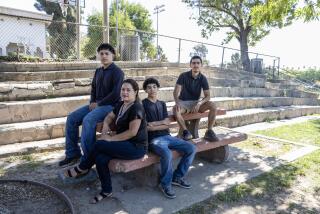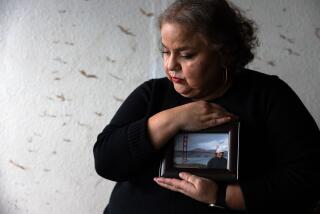In Land of Opportunity, Joblessness Frustrates Newcomers
- Share via
SAN JOSE — Every afternoon, Rashmi Chethan and her female Indian friends gather to drink chai, stroll around their sprawling San Jose apartment complex and console each other over their stalled careers.
The group includes doctors, lawyers, computer scientists and a nuclear engineer. Their husbands are computer stars in the Silicon Valley, programming and design whizzes granted special high-tech visas that allow them to work in laboratories, software mills and Internet shops for up to six years. But under the terms of the companion visas that brought them to the United States, Chethan and her friends are not allowed to work.
If they still lived in India, many would have promising careers. Here in the land of opportunity, their restrictive visas prohibit them from utilizing their skills. When they came here, they became housewives. They stay at home now, rarely learn to drive and don’t have money of their own. Paradoxically, these women find themselves more dependent on their husbands than they would be in India, where they were part of that country’s cosmopolitan elite.
According to the State Department, of the 115,000 special high-tech visas--or H1B visas--issued last year, nearly half went to Indian men. Accompanying the computer engineers were more than 70,000 dependents like Chethan, a trained engineer, who travel on much more restrictive H4 visas. In California, these H4 Indian women are concentrated in the Silicon Valley and other computer-rich communities.
To combat their loneliness and enforced idleness, the women formed a club they jokingly call the WWF--Wipro Women’s Federation--named after Wipro, an Indian-based, international information technology company.
One recent afternoon, Chethan and nine other young WWF wives gathered in a sparsely decorated apartment and passed around photos of their recent trips to Lake Tahoe and Santa Cruz, while several toddlers crawled from lap to lap. Most wore salwar-kameez--the loose pants and long top favored by young Indian women. They spoke an easy mix of Hindi, Telegu and English. The women of the WWF come from cities such as Bangalore, Hyderabad and Madras, Indian counterparts to the Silicon Valley.
The majority of women in India still live in poverty, are illiterate and are expected to defer to men. But the few who are born into the higher castes and classes are often relatively wealthy and highly educated. These women compete with their male counterparts for places at the nation’s best universities and, in a country where most women are housewives or laborers, often work in professional jobs, even after marriage. They are sophisticated, independent and speak English as fluently as in their mother tongues.
Nirmaljit Kaur is a typical H4 holder. Two weeks after she graduated from medical school and got married, she left New Delhi to join her new husband in San Jose. Kaur had barely gotten to know him, let alone discuss with him the terms of her stay in the United States.
In India, where arranged marriages are still the norm throughout society, parents see young men with high-tech American jobs as attractive prospects for their daughters. In matrimonial ads found in every Indian newspaper, a visa to work abroad has become another important category, like caste, education and family background. Young women usually meet their husbands only a few times before marriage. All Kaur knew was that he had landed a promising job as an applications engineer at a large semiconductor company in the Silicon Valley.
Kaur is an energetic and expressive 25-year-old with a brown ponytail that reaches halfway down her back. Sitting in the tiny kitchen of her one-bedroom San Jose apartment, she says that she, like other immigrants, thought that once she arrived, everything would be easy. “People think as soon as you get here, you get a diamond mine and your life is a bed of roses. But there are big spikes in it,” she says.
She spent most of her first year in the U.S. at home while her husband was at work. She didn’t have a community of family and friends like she had in India. Suddenly dependent on her husband and unable to pursue her own career, she became lonely and depressed. She felt purposeless. “Coming here broke my self-confidence. As a doctor, you feel like you can do anything,” she says. “Then you get here and you are lost.”
After the first year, partly out of worry that potential employers would frown upon this bureaucratically forced gap in her resume, Kaur volunteered as an unpaid medical researcher at Stanford University, where she has put in more than 4,000 hours over a two-year period.
Other women in her situation have stayed at home. They include a New Delhi television executive who says she would even work at McDonald’s if she could, but since she can’t, she has decided to have a child; and a north Indian woman with a degree in nuclear engineering who is going back to college.
Most dependent spouses hoped that once they got here, they would be able to change their visa from the restrictive H4 status to one allowing them to work.
“The thing with the H4 is that it is easy to get, but hard to get out of,” says Kaur. In order to work, the women have to find an employer willing to sponsor their new visa, or their husbands have to procure a green card, which would grant permanent residency and allow both spouses to work.
Waiting for a green card can take years. The INS has a five-year backlog of green-card applicants. Couples who wait for years sometimes have to return to their home countries when the husband’s temporary work visa expires.
In the meantime, returning to college is a common strategy for women who are desperate for sponsorship. Computer-science classes are now regularly oversubscribed in the Silicon Valley, and most of the people on the waiting lists are Indian women. (While female computer science-degree holders are not unheard of in India, few apply for H1B visas because of cultural barriers against Indian women moving abroad alone, WWF members say).
One former H4 holder says that when she was working toward her master’s in computer science, she and her Indian friends adopted a nickname for San Jose State University: “San Jose Spouses” University.’
Sandra Jardin, an international admissions technician at Cal State Hayward, says, “My average student is an Indian woman on an H4 visa studying computer science in the master’s program.” For these women, computer-science degrees are the best way to improve their chances of getting Silicon Valley’s high-tech companies to sponsor their work visas.
Chethan is one of these students. The 24-year-old from Bangalore already has her master’s degree in engineering and is pursuing a second master’s in computer science at Cal State Hayward. When she first arrived in the U.S. three weeks after her wedding, she looked forward to taking time off to get to know her husband.
But he works all day as a computer programmer, and despite being a student, she was alone most of the time. “I just cried for two months,” she says. “Staying alone was very, very difficult.”
Chethan noticed that a lot of her neighbors in her apartment complex were also young Indian women who seemed to be staying at home too. She got to know some of them, and so began the WWF. The group has grown to 30 women, who, in addition to taking afternoon walks around the neighborhood, hold potlucks together every other week.
The women make a point of reaching out to newcomers because they know that the first few weeks in the U.S. are the hardest, when culture shock is most acute. “We are meeting daily so we won’t think about it,” says one member of the group. “You have to be busy here. If not, it’s very difficult. Without family, you have to have friends.”
Many of these women are living apart from their families for the first time, and this network of friends functions as an extended family away. The children of the group call their mothers’ friends “auntie.”
Chethan feels unsatisfied with being a housewife and going to WWF events. That’s why she’s in school. She plans to switch from her dependent visa to a student visa, which will allow her to work as an intern after getting her degree. That internship, she hopes, will pave the way in finding an employer willing to sponsor her work visa. At least Chethan has a plan. Most wives are just waiting for their husbands’ green card applications to be approved.
“An increasing number of people are biting their nails, wondering if they’re going to make it,” says B. Lindsay Lowell of Georgetown’s Institute for the Study of International Migration.
Yet like many H4 visa holders, Chethan says that despite the challenges, it has given her husband a chance to advance his career and make money, and has proven an adventure in American-style independence.
“I love this place,” says Kaur. “If I didn’t have a career, I would be very happy here. California is the most beautiful place in the world.”
More to Read
Sign up for Essential California
The most important California stories and recommendations in your inbox every morning.
You may occasionally receive promotional content from the Los Angeles Times.












